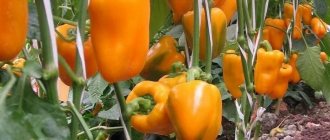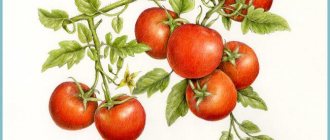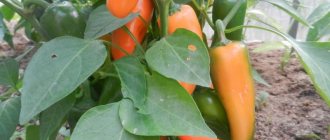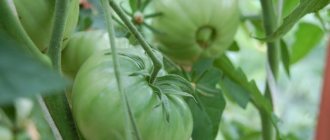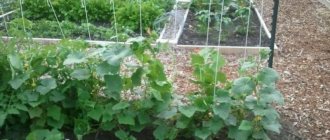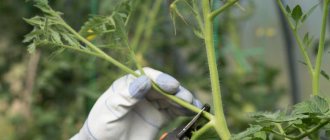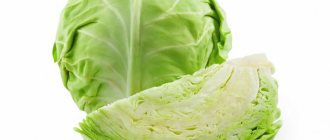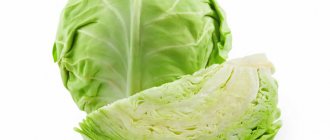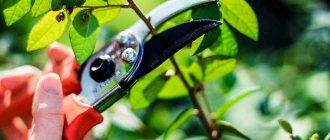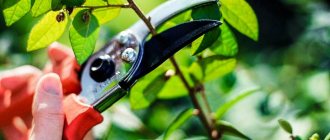To obtain a good harvest, it is important to shape the bell pepper. Read more in the article.
According to experienced summer residents, the process of plant formation is the main way to increase the yield and size of future fruits. Novice vegetable growers extremely rarely use this technique, believing that the plant will give a good harvest without the formation procedure, and that it is possible to get by only with watering and fertilizing. However, shaping is not a single procedure involving cutting and pinching. This process has a large number of stages and includes many techniques.
Read another article on our website on the topic: “What can you cook from bell peppers for the winter?” . You will find recipes for preparing sweet bell peppers for the winter. You will also find tips on drying, freezing, and pickling. This article also contains the best recipes for preparing stuffed vegetables, fried bell peppers, in tomato-garlic sauce, caviar, lecho, and adjika from bell peppers for the winter.
A pepper bush, formed according to all the rules, will have a beautiful appearance and will be able to please the vegetable grower with a good harvest. How to do this correctly, read on.
Varieties of bell pepper: features of their formation
Bell pepper
When starting to form bell pepper, it is worth considering the characteristics of each variety. Here is a list of them and the features of their formation:
- Tall pepper : when shaping, it is necessary to carry out the pinching procedure, as well as cut off shoots that are unnecessary and that interfere with growth.
- Medium-sized pepper : it is important to remove fruitless side shoots. This will increase the light supply and allow air to circulate around the plants more well.
- Low-growing and dwarf peppers : these types do not require special shaping. When growing them, it will be enough to remove weak shoots without fruits.
Pinching the crop must be done very carefully. Follow all rules.
Rules and exceptions
Speaking about the rules for the formation of peppers, experts and experienced gardeners remind that the main rule of picking is to remove all the stepsons and leaves that are located below the main branches. Even if flowers form on them, these parts of the plant are not needed for further fruiting.
Then, two or three main shoots are left. Next, when a fork forms on the main shoot, pinch off the growing point, saving the rest for further growth. On the remaining shoots, it is also important to ensure that the main leaves and fruit remain, and it is also better to pinch the growing point. You need to do the same with the rest of the main and side shoots.
Sometimes the plant itself forms 3 shoots. In this case, pinching is not required. It itself forms a sufficient number of ovaries and fruits. If pollination is weak, it is advisable to do it yourself, using a regular small brush. We collect pollen with a brush and apply it to the stigma of the flower. This way you can be sure that all the flowers will yield a harvest as a result.
Formation is necessary for tall and large types of pepper. Low-growing varieties, as well as those varieties that have a weak branching ability, do not need to be formed. Most hybrid varieties also do not need to be formed, since they do not grow excessively.
Low-branching varieties that do not require formation include:
- Florida,
- Zodiac,
- Barguzin,
- Alesha Popovich,
- Bagration,
- Victoria,
- Bogatyr.
Hybrid varieties with weak branching:
- Pinocchio F1,
- Othello F1,
- Claudio F1,
- Maxim F1,
- Goodwin F.
They also do not require special formation.
Rules for forming bell peppers
In order to reap a rich harvest of bell peppers in the future, you need to know the rules of formation:
- Low-growing varieties must be allowed to grow freely.
- There should be few ovaries, then the size of the pods will increase.
- Pinching increases the speed of ripening.
- Do not leave stepchildren until the first fork is pecked.
- Remove all shoots directed into the bush.
- When forming a bush, it is worth leaving 2-3 trunks.
- Frame shoots should grow freely.
- The blind branches above the ovaries must have 1-2 leaves to receive nutrition.
- Tall varieties need to be tied up (each shoot separately).
- The fruits on the frame branches should be distributed evenly.
The shoots should be removed when this can be done without injuring the bush itself.
Stage three - removal of barren shoots and lower leaves
During the entire growing season, pepper bushes must be inspected every week. This will allow timely detection and removal of side shoots (stepchildren) that appear from the leaf axils below the first fork. These shoots are called sterile.
Barren shoots are broken off at the base. It is advisable to do this when the height of the stepson is small, in order to less injure the main stem of the bush.
In addition to the stepsons, excess foliage is also removed from the pepper bushes. Begin pruning as the fruits form:
- when the flower on the second fork fades, you can start removing all the leaves below it, 2-3 pieces at a time. in 1-2 days;
- As the next flowers fade, the foliage below them continues to be removed;
- The bush should not be deprived of those leaves that are located on the periphery of the crown; the trunk is exposed no more than 1/3 of the height from the ground.
Methods for shaping bell peppers
There are several different ways to shape bell peppers:
- Removing inflorescences : growing to 20-25 cm , the skeletal stem begins to branch. Buds grow in the bifurcation area. They must be removed for the further, correct branching process.
- Pinching shoots : a proper bush should have a stem and a couple of strong shoots coming from the inflorescence. Other branches should be removed by pruning.
- In one stem : when the bushes are located at a small distance from each other, the crops are able to unite into one stem. In such a situation, it will not be possible to harvest from large bushes, so they need to be discharged to improve ventilation and nutrition of each plant.
If the first two methods are clear, you need to remove the buds or pinch the shoots. The process of formation “ into one stem ” is not always clear, especially to novice gardeners. It looks like this:
- The first stage should begin when branches arise.
- All growing shoots are pinched; only the main stem on which the ovary is located needs to be preserved.
- Fresh forks that appear on the skeletal stem should also be removed.
- After 12 fruits ripen on the bush, pinch the crown.
Method for forming bell peppers
There is one more method - “in two stems”. This is the most common forming option. As a result, the plant should have a V-shaped design . This method allows you to collect about 25 fruits from 1 plant. The process has the following sequence:
- The skeletal growth of the first order grows into 2 processes of the second order. The strongest shoot is left untouched. It will support other processes located above and is considered skeletal. Leave buds with leaves on this shoot. The second process is usually weaker. Pinch it off, keeping the fruit with leaves.
- The main shoot of the second order is divided into two processes, which will have a third order. It is also necessary to isolate the skeletal process from these branches. He will develop and grow well. In the axils of the leaves of the main shoot, remove all the stepsons. In addition, all yellowed leaves should be removed from the main branches. Pinch the weakest third-order shoot at the top, where the flower bud is located. It is imperative to leave one leaf, which will nourish all the ovaries.
- A similar process is carried out with the first-order skeletal process of the second branch (1st fork). The bush is divided into two stems. If you keep two side shoots on the trunk instead of one, then you will get 4 main branches. One needs to be cut off.
- After 20-26 fruits ripen on the bush, cut off the tops of the plant.
- After cutting off the top, the nutrients will be redirected to the young ovaries.
Another popular way of forming “in three stems” :
- To grow three-stem peppers, you need to have a large greenhouse, but this method will bring the richest harvest.
- With this planting option, each bush receives maximum nutrition and lighting.
Choose the most suitable method for yourself. The formation stages are described below. Read on.
Peculiarities
When growing in a traditional polycarbonate greenhouse, excess parts of the plant must be removed. This must be done carefully, in accordance with the rules, so as not to harm the plant. The following procedures are carried out at different stages of cultivation:
Removing crown buds. A flower bud is formed when the main stem reaches a height of 20-25 cm. At this moment, the process of its branching begins. And for it to proceed safely, the so-called crown bud should be removed. They do this immediately after its appearance.
Pinching shoots. A healthy and fruit-bearing pepper should have 2-3 strong and healthy shoots. All shoots that appear besides them should be removed. It is better to do this by cutting off the top or growth point of the shoots.
Removing the lower leaves. The lower leaves, as well as the barren shoots, often grow if they are not removed. It is important to get rid of them in a timely manner, since these parts of the plant can shade the planting and impair the quality of pollination.
After a large number of ripe fruits have been collected, the skeletal branches are pinched. All growth points located on the main stems of the plant are removed. The main goal of this procedure is to reduce the growth of the green part of the plant. Thus, it will be possible to direct all the energy to feed the rest of the crop, which is just ripening at this moment.
If you remove excess parts of the plant correctly and in accordance with technology, it will be able to direct all the nutrients to the formation and growth of fruits.
Pinching helps to get rid of the bush being overloaded with a large number of ovaries and inflorescences. Properly formed plants fully receive sunlight and fresh air.
The bush looks more harmonious and beautiful.
Why do they do this and when do they start?
The results of correct and timely execution of bush formation are noticeable when fruits appear on it. There may not be as many fruits as in the case of unformed plants, but they are larger and fleshier, have thick and juicy walls. Peppers grown on mature bushes are usually tastier and meatier.
But not only the quality of the fruit indicates that the formation of a bush is necessary. Thanks to this procedure, the ventilation of the plants is improved and their care is made easier.
There is an opinion that the formation of bushes should begin when the ovaries appear or when the plant reaches a certain height. But a more correct method is to begin formation immediately after the first fork appears on the central stem. Until this point, no action is required.
When transplanting seedlings into a greenhouse, formation should begin only when it takes root well and produces new leaves. Before the bush gets stronger in its new place, any manipulation can only weaken it.
In addition, pinching immediately after transplanting into a greenhouse can lead to more abundant growth of the plant to the detriment of the fruits.
The time for formation may vary depending on the climatic conditions in a particular region.
It is better to pinch the tops of the stems in the middle or end of August. By this time the fruit should begin to set. As a result of this procedure, future peppers will ripen faster.
If we briefly and consistently describe the formation scheme, it will look like this:
- When a flower appears on a fork of branches at a height of 25 cm, remove it immediately.
- If we notice that shoots – stepchildren – have appeared below the skeletal branches, we also cut them off. We repeat this procedure all the time while the bush is in the process of growth and development.
- When the next fork appears, we choose the strongest one. On the weaker one, we leave only one internode, at the end of which there is a leaf sinus. We pinch the branch immediately after the axil, leaving the leaves.
- We leave 5 or 6 ovaries on all branches. Then, to stop the growth of the top of the branch, we pinch it. You can also pinch the crown about 40 days before the end of the growing season. If the variety is tall or hybrid, the number of ovaries can be unlimited. In this case, when pinching the crown, you need to pay attention only to the approximate end date of the growing season.
- To set fruit, artificial pollination can be carried out using a brush, touching the stamens with anthers and pistils of flowers.
We process all skeletal branches in the same way. Crown buds sometimes need not be removed. This applies only to those cases where it is planned to collect seeds for further planting. The seeds in such a bud will be the best.
This scheme works best with medium-sized varieties. The short ones are formed a little differently.
I recommend watching the video (be sure to watch it to the end), you will learn a lot of new things:
Stages of formation of bell pepper: diagram
When forming a plant using the stem method, you need to install trellises so that branches of all orders are attached to the transverse fasteners. Here's the diagram:
Stage of formation of bell pepper
Remember: A large number of fruits can break thin branches.
Low-growing, hybrid and weakly branching varieties do not require formation.
Worth knowing:
- Perform processing when the first branches appear.
- In cases where the number of sprouts that appear is more than 3 , the excess ones are removed.
- If the number of shoots on a branch is less than 3 , then you need to leave the lower shoots on the skeletal stem. When they grow, keep the strongest one and remove the rest.
- After a fork appears on the stems of the first order, all weakened, thin shoots are cut off and one, stronger one is left.
- The cut should be repeated for the main branches of new orders until 25 to 30 fruits .
- Then cut off the top of the plant to remove the growing point. This will give the bush the opportunity to form a rich harvest.
On the main stems of all orders, new leaves and ovaries may soon appear. They need to be cut off gradually. First, those leaves that shade the ovaries must be removed. This procedure must be repeated until the bush grows to a height of one meter. So that there is no more growth, and the beneficial substances go to the lower fruits and ovaries, the top is cut off. In 1.5 months. Before harvesting fruits, the top of the main branches of all orders must be cut off so that beneficial microelements are redirected to the lower fruits.
Worth knowing: On formed bushes of plants, about 20-25 large, thick-walled fruits are usually preserved. With the onset of autumn, a large number of small ovaries and fruits will appear on unformed bushes.
Remember:
- When growing peppers in the garden - in the open air, and not in greenhouse conditions, you need to form only tall varieties.
- For a medium-sized species, only barren shoots with stepsons need to be removed to provide the bushes with sufficient oxygen and light.
- The low-growing species does not need to be processed.
Important: All inward growing, broken and crooked processes are subject to the removal procedure. Bushes of medium-sized and low-growing peppers need pinching of the central shoots to enhance lateral branching.
Stages of formation of bell pepper - sequence:
- As soon as the pepper gets stronger and reaches a height of 25-30 cm , it is necessary to remove all the primary buds.
- In addition, cut off the buds on the side shoots, this will stimulate the growth of additional branches. The seedlings will begin to bush.
- All subsequent shoots should be formed in the same way: remove the stems and leave 3-5 branches .
- On the skeletal process, before the first fork, remove shoots and leaves.
- All main trunks should be pruned at the point of growth after a large number of fruits have appeared.
- Perform the final pruning procedure several weeks before the end of fruiting.
The total number of fruiting shoots should not be more than 4-6 pieces, and 15-25 .
Stage one - removal of the crown bud
There are slightly branching varieties of sweet peppers that do not require additional pruning. These are low-growing hybrids and varieties (Florida, Podarok Moldova, Maxim F1, Buratino F1, etc.).
Both low-growing (40-60 cm) and tall (up to 1 m) pepper bushes must be subjected to removal of the crown bud. This is the name of the flower bud that appears at the top of the bush when it reaches a height of 15-20 cm. After the crown bud appears, the bush begins to branch: 2 shoots of the first fork develop on the sides of the flower. If the flower bud is not removed in time, the plant will direct maximum nutrients to its development, and the remaining branches of the crown will receive less nutrition.
You need to remove the crown bud manually: break it off along with the stalk or cut it off with scissors. Sometimes 2-3 buds appear in the first fork. In this case, you need to remove them all.
Greenhouse growing of bell peppers: principle
When transferring seedlings to a greenhouse, they must be planted in such a way that there is always space to increase the volume by several bushes. The planting scheme for the most bushy species can be 5-6 pieces per square meter. With average bushiness, plant 6-8 bushes per meter.
Greenhouse growing of bell peppers
The principle of greenhouse formation of bell pepper is to rid the plant of barren shoots:
- After the plant has taken root at the planting site, it must be constantly inspected and treated for parasites.
- Barren shoots growing on the trunk before the first fork begins should be removed to provide the bushes with good lighting and air circulation.
Greenhouse pinching of bell pepper
Pepper shoots that appear after branching are called lateral shoots . These processes are skeletal. Each of these shoots initially grows as a central stem with leaves. Subsequently, new shoots, called stepsons . These shoots must be removed by pinching.
Basic Techniques
It will be useful for novice gardeners to learn how to correctly carry out pepper formation operations. Use your own nails or scissors as a tool. You can buy special ones, or take any - smooth, medium-sized, with sharp tips.
The stems and leaves of peppers do not stain your hands as much as tomatoes. You don't have to worry about your manicure.
Stepsoning
The stepson is a lateral shoot that appears from the axil of the leaf of the main stem. Over time, it develops into a full-fledged shoot, capable of blooming and bearing fruit.
When forming a bush, all stepsons below the fork are removed, the rest are blinded, that is, the top is plucked out, leaving the ovary and 1-2 leaves.
It is convenient to do this with fingernails or scissors as soon as the shoots reach 2-3 cm. To avoid infection, leave a stump of 3 mm.
Pinching buds
Actually, only one bud is pinched - the crown one, the formation of which occurs in the first fork. It is an inhibitor - it slows down the development of the bush, the formation of ovaries and the filling of fruits. But he grows big and beautiful.
It should be removed as soon as the bud appears, which often happens before transplanting into the ground. This is the only pepper formation operation that can and should be carried out on seedlings.
The crown ovary is left only in one case - when they are going to collect their own seeds. It is this fruit that will provide the highest quality planting material.
Trimming
The lower leaves on a first-order shoot are usually quite hard at the time of removal so that they can be easily plucked off with fingernails. Therefore, they are cut with scissors, leaving a stump of 3 mm. You can also cut your stepsons. It’s just as convenient for anyone.
The formation of bell pepper bushes is usually not carried out as carefully as tall Dutch hybrids. There, the stepsons can outgrow, they are cut out and not plucked out, like fattening or thickening shoots.
Mistakes when forming and growing bell peppers
The formation of a bell pepper bush actually begins with the planting process. A gardener must know not only how to prune or pinch a bush, but also how to properly plant, fertilize and water plants. Here are the mistakes when forming and growing bell peppers:
- Violation of planting deadlines : pepper seedlings need to be planted only after the threat of return of spring frosts has disappeared, otherwise the plant may die. According to reviews from experienced vegetable growers, in the middle zone, seedlings begin to be planted in open ground in late May - early June. You can plant seedlings in closed structures already at the end of April, and in heated greenhouses - in mid-March.
- Excessive nutrition with fertilizers : at the beginning of the growing season, like other nightshade crops, pepper needs nitrogen fertilizing. However, you should not overdo it with fertilizers, because overfeeding leads to excessive formation of useless green mass. You need to water the seedlings once, after rooting. As a fertilizer, you can use a weak solution of urea (one dessert spoon per 10 liters of water) or a weak solution of slurry (1:10).
- Violation of the temperature regime : if the bushes have many peduncles, but ovaries do not form at all, then the plant is experiencing problems with pollination. This can occur due to high air humidity, for example, in a greenhouse, as well as sudden temperature fluctuations. Heat and cold are equally harmful to plants. It is necessary to reduce watering, constantly ventilate closed structures during hot weather and heat during cold weather. It is necessary to treat the seedlings with preparations that improve the appearance of ovaries.
- Improper watering : both deficiency and excess of water in the soil are equally harmful. When watered with ice water or the soil dries out, the ovaries and flowers begin to fall off en masse. Plants need to be watered with settled water, heated once every 3-7 days, when 2-3 cm of the top layer of soil has dried.
- Inadequate nutrition : A lack of minerals such as calcium, magnesium and potassium combined with cold weather can lead to the formation of fruit rot. Ripening fruits on diseased plants begin to rot at the point where the stalk attaches. During cold summers, you need to use foliar feeding with the addition of phosphorus-potassium fertilizers.
- Cross-pollination of sweet and savory varieties when they are in the same greenhouse.
- Long exposure of seeds in potassium permanganate : this substance removes all harmful microorganisms from this material well. However, too strong a solution and too long exposure of the seeds can lead to combustion of the material.
Experienced vegetable growers advise using a solution of no more than 0.5 percent strength and keeping the seeds in it for no longer than 25 minutes. To prepare such a solution, you need to dilute 0.5 teaspoon of manganese in 600 milliliters of water.
Why shape the pepper?
The formation of a certain type of crown in pepper bushes contributes to:
- increasing the strength and stability of the plant, which is especially important for dense plantings and frequent opening of the greenhouse, when the risk of damage to the bushes from gusts of wind increases;
- cleansing the plant of shoots that do not produce ovaries, but suck the juices from the plant;
- facilitating access to sunlight for all green parts of the bush;
- uniform fruit ripening;
- improving ventilation of the root system;
- reducing the load on the bush (due to an excessive number of ovaries, the stem may break and the plant will die);
- increasing the aesthetic appeal of the plant.
By cutting off excess green mass, the vegetable grower stimulates the pepper to channel all its vital juices into the formation of large and sweet fruits.
Manual formation of bushes allows peppers to ripen at the same time, which is of no small importance for a gardener growing vegetables for himself. On an industrial scale, pruning bushes helps to obtain a more presentable harvest that is in good demand among buyers. Peppers grown without outside intervention will have fruits of different sizes, and they will also ripen at different times.
Pests of bell pepper
Pests of bell pepper
Dangerous pests for bell pepper are whiteflies, thrips, and May beetle larvae. Greenhouse plants are most often attacked by aphids. Fertilizing and adding potassium-phosphorus fertilizers to the soil are very helpful in controlling pests. In addition, drugs created on the basis of quickly decomposing biological toxins or viruses that kill parasites have a good effect. Such substances are safe for humans and plants. Spraying crops to get rid of pests is best done exclusively in the morning.
- Bell pepper is a very smart crop.
- Therefore, by carefully observing it, you can quickly understand that the plant is sick.
- The main signs of the disease are: discoloration and yellowing of leaves, fading.
- A timely reaction and subsequent care of the plant will allow it to quickly recover and continue to bear fruit.
During flowering and budding, you need to add plant ash in the amount of 1-2 cups per linear meter (before watering). You can additionally treat plants with drugs that increase stress resistance and immunity, for example: Zircon, Ecoberin, Silcom. This procedure should be performed in the morning, having prepared the solution in advance, following the instructions on the package.
Topping
The second way to increase the number of fruits is to pinch the stem with a clothespin (in the area of the fifth to eighth leaf) before that royal bud begins to set. This will allow you not to lose the first flower and direct the growth of the plant into lateral shoots and also increase the number of ovaries.
In addition, both methods allow the plant to grasp the soil more firmly by expanding the root system, and this increases its resistance to physical damage. This will also increase the consumption of nutrients from the soil. Of course, these methods should not be the only methods of increasing yield; we should not forget about more traditional methods and fertilizers.
Proper care of peppers after formation
Bell pepper when properly formed
Formation is a serious stress for the plant due to the fact that many leaves and shoots are removed from it. After this process, the plant requires high-quality and proper care to restore and continue growth:
- First of all, the pepper must be tied to a support so that its branches do not break under the weight of the fruit.
- Constantly spray the crop with warm water.
- Water in the early morning or late evening.
- The following waterings must be combined with the process of applying fertilizer.
By following the advice and recommendations of experienced gardeners, you can avoid the most common mistakes when growing bell peppers. Good luck!
Recommendations from experienced vegetable growers
If the pepper was formed according to certain rules, then all that remains for the vegetable grower is to continue to care for it in accordance with the requirements of the crop. At the same time, we must not forget that any manipulation with the plant causes discomfort to it. After pinching, pinching and trimming the pepper, no additional procedures should be carried out. Bushes need time to recover. To reduce the risk of bush death after crown formation, it is recommended:
- remove buds, leaves and tops of shoots at different times with an interval of 5-7 days;
- do not water, spray or fertilize newly pruned bushes (an injured plant is not able to absorb the substances it needs, excess moisture can damage the roots, and the process of rotting will begin).
Pruning is carried out only in dry weather, early in the morning or in the evening after sunset. It is especially important to follow this recommendation for those owners of greenhouses who open them for the summer, almost completely removing the film.
The formation of pepper bushes is considered one of the important agrotechnical procedures carried out in order to accelerate the growth and ripening of fruits, as well as the most convenient placement of a large number of plants in a limited area.
If you don't pinch the peppers
Neglecting the pinching procedure when growing tall varieties leads to the following consequences:
- poorly developed root system - as a result, the bush receives insufficient water and nutrients;
- decrease in yield indicators - new shoots grow from internodes, on which additional fruits are formed;
- without pinching, tall varieties actively increase green mass, the bush grows powerful, and the fruits become small and thin-walled;
- Without shaping, the bushes grow greatly, they become crowded, and the plants begin to hurt.
If the seed manufacturer recommends shaping the plants , these recommendations should not be ignored.
